
The planes of the Dungeons & Dragons roleplaying game constitute the multiverse in which the game takes place. Each plane is a universe with its own rules with regard to gravity, geography, magic and morality. There have been various official cosmologies over the course of the different editions of the game; these cosmologies describe the structure of the standard Dungeons & Dragons multiverse.
Several different editions of the Dungeons & Dragons (D&D) fantasy role-playing game have been produced since 1974. The current publisher of D&D, Wizards of the Coast, produces new materials only for the most current edition of the game. However, many D&D fans continue to play older versions of the game and some third-party companies continue to publish materials compatible with these older editions.
The paladin is one of the standard playable character classes in most editions of the Dungeons & Dragons fantasy role-playing game. The paladin is a holy knight, crusading in the name of good and order, and is a divine spellcaster.
A character class is a fundamental part of the identity and nature of characters in the Dungeons & Dragons role-playing game. A character's capabilities, strengths, and weaknesses are largely defined by their class; choosing a class is one of the first steps a player takes to create a Dungeons & Dragons player character. A character's class affects a character's available skills and abilities. A well-rounded party of characters requires a variety of abilities offered by the classes found within the game.
The warlock is a character class in the Dungeons & Dragons fantasy role-playing game. It was introduced as a non-core base class who practice arcane magic in the supplemental book Complete Arcane for the 3.5 edition of Dungeons & Dragons. In 4th and 5th edition, the warlock is a core class.

Tome of Battle: The Book of Nine Swords is an official supplement for the 3.5 edition of the Dungeons & Dragons role-playing game, published by Wizards of the Coast in 2006. The book chronicles the rise and fall of the fictional Temple of Nine Swords within the D&D universe and introduces an entirely new "initiator" subsystem that gives greater flexibility.

Michael Mearls is an American writer and designer of fantasy role-playing games (RPGs) and related fiction.

Dark Sun is an original Dungeons & Dragons (D&D) campaign setting set in the fictional, post-apocalyptic desert world of Athas. Dark Sun featured an innovative metaplot, influential art work, dark themes, and a genre-bending take on traditional fantasy role-playing. The product line began with the original Dark Sun Boxed Set released for D&D's 2nd edition in 1991, originally ran until 1996, and was one of TSR's most successful releases.

The Dungeon Master's Kit is a box set released as part of the Essentials line of the 4th edition of the Dungeons & Dragons role-playing game. It is intended for primary use by the game's Dungeon Master.
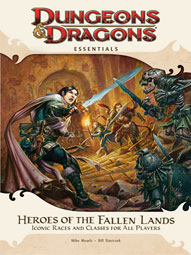
Heroes of the Fallen Lands is a supplement to the 4th edition of the Dungeons & Dragons role-playing game.

Heroes of Forgotten Kingdoms is a supplement to the 4th edition of the Dungeons & Dragons role-playing game.
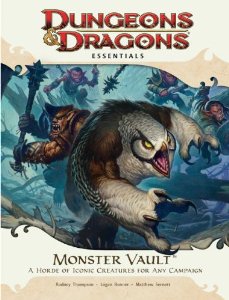
Monster Vault is a supplement to the 4th edition of the Dungeons & Dragons role-playing game.

The Shadowfell: Gloomwrought and Beyond is a supplement for the 4th edition of the Dungeons & Dragons fantasy role-playing game.
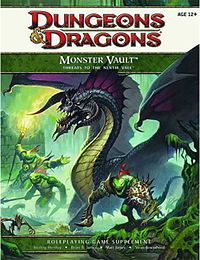
Monster Vault: Threats to the Nentir Vale is a supplement to the 4th edition of the Dungeons & Dragons role-playing game. Bart Carroll, Producer at Wizards of the Coast, wrote: "In this book, you'll find a codex of monsters and villains to throw at the heroes as they explore every nook and cranny of the Nentir Vale or, by extension, your home campaign setting".
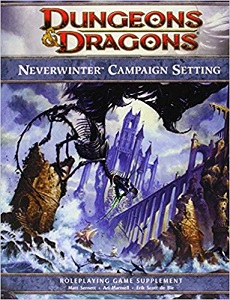
Neverwinter Campaign Setting is a supplement to the 4th edition of the Dungeons & Dragons role-playing game.
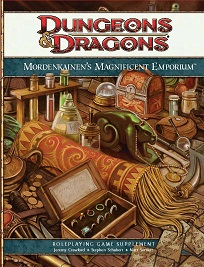
Mordenkainen's Magnificent Emporium is a supplement to the 4th edition of the Dungeons & Dragons role-playing game. While this book was published after the Essentials line officially ended in 2010, it served as a replacement for the main magical item supplements, Adventurer's Vaults (2008-2009), from the Essentials line.

Madness at Gardmore Abbey is an adventure for the 4th edition of the Dungeons & Dragons role-playing game. It was the third super-adventure for the edition and it was part of the Essentials line.
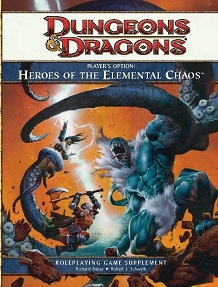
Heroes of the Elemental Chaos is a supplement to the 4th edition of the Dungeons & Dragons role-playing game. This book is one of three source books, along with Manual of the Planes (2008) and The Plane Below: Secrets of the Elemental Chaos (2009), from this era that details the Elemental Chaos from the 4th edition World Axis cosmology.

Keep on the Shadowfell is the first official product from the 4th edition Dungeons & Dragons ("D&D") line. It is part one of a three-part series of adventures. It introduces a series of 4th edition Dungeons & Dragons settings called the Points of Light, a loosely connected and open-ended series of settings designed to allow other modules and fan-created content to be integrated seamlessly into the settings' largely unmapped fantasy world or the Dungeon Master's own custom-made setting. The adventure, written by Mike Mearls and Bruce R. Cordell, was published in 2008 by Wizards of the Coast. It is followed by the sequels Thunderspire Labyrinth and Pyramid of Shadows. The adventure is designed for characters from levels 1 to 3. Its module code, "H", stands for Heroic Tier. This module is set in a region of the world called the Nentir Vale, which is described in greater detail in the 4th edition Dungeon Master's Guide.















